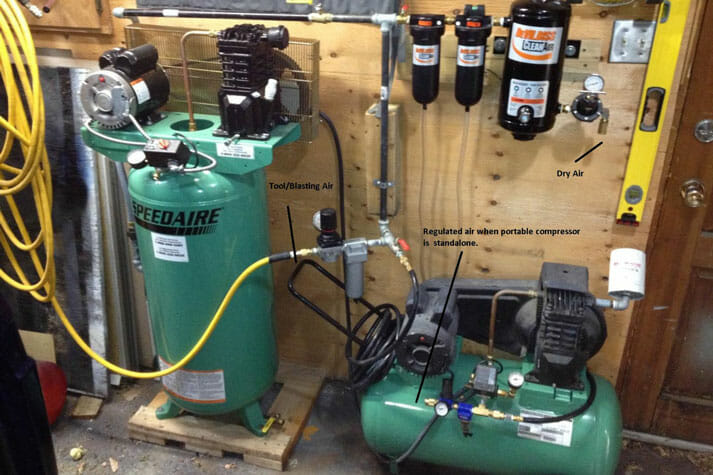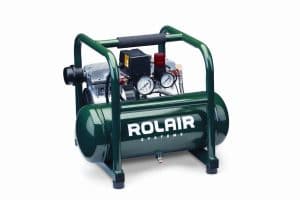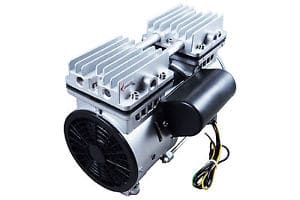It’s no surprise that air compressors are gradually growing in popularity as a need-to-have tool for any carpenter or builder. However, what would surprise you are the gradually growing numbers of air compressor related accidents.
It’s not unusual for even the most experienced worker to forget how dangerous an air compressor can be. An improperly set-up air compressor has the tendency to overheating, fires, explosions, and even death.
That’s why we’ve composed an in-depth review of how to use and setup an air compressor.
In these next few sections, we’ll provide step-by-step directions for setting up and handling air compressors. Our goal, through this, is to guarantee safer handling and better results.
If you’re a new carpenter, woodworker, or builder, I recommend that you read through our list. We’ve also included helpful tips for using an air compressor. Hopefully, with all this, you’ll be able to handle an air compressor without mistakes, accidents, or injuries.
List of Steps (Click on the play button to launch the video)
1. Safety
Before you get started, you should always make sure that you’re wearing the proper safety equipment. This means that you should have on goggles or an eye guard to protect your eyes from flying debris. You should wear a hard hat and hard boots, just in case something pops off or the air compressor malfunctions. Thick gloves are also handy in case the air compressor explodes. Finally, you should wear some type of hearing protection, such as earmuffs or earplugs. Air compressors are very loud power tools, and excessive use without protection can cause permanent damage to your ears.
2. Don’t Use a Power Extension Lead
It’s important to remember that you shouldn’t use a power extension lead on an air compressor. This is because power extension leads may be too long for the air compressor to handle. Air compressors are manufactured to handle as certain lead length. If the power extension lead is too long it can cause voltage drops and even burn out the unit. However, if you really have to use an extension, make sure that it’s a hose reel extension. This allows for more space and maneuvering in the work place.
Also, it’s important to consider what internal diameter (ID) your hose should have. If the air compressor has a fairly high PSI average, then you may need a house with a wider ID.
3. Check the Oil Level
Next step is to check the air compressor’s oil level. This can be seen via the sight glass. The oil level should be equal to the red line. If it’s not, simply remove the bung and fill the unit until the oil is level with the red line. It’s important to consult the manufacturer’s manual as to what type of oil the power tool requires. Also, you should regularly lubricate the air compressor and air tools to keep it maintained and functional.
4. Attach the Air Filter

An air filter’s job is to filter out dirt and debris that may be sucked up into the air compressor. This is important for guaranteeing a smooth, debris-free finish when using an air compressor to spray paint. It also keeps your air compressor from malfunctioning, breaking down, or clogging on environmental debris. That’s why you remember to screw the air filter onto the side of the 12v air compressor before you get started.
5. Insert the Oil Plug
Next up is the oil plug. Make sure that you’ve drained the old oil adequately and, after refilling it (step 3), that the oil plug is firmly in place.
6. Plug-in the Air Compressor
The next step is simple. Just plug the air compressor’s electrical cord into an outlet. If need be, remember to turn the socket’s power on. Make sure that the air compressor’s electrical cord is not in anyone’s way. If it’s just hanging in mid-air, it may become a potential tripping hazard. This is extremely dangerous when power tools are involved, so make sure that the electrical cord is put away.
7. Turn on the Power
This step is definitely the easiest. Simply turn on the air compressor.
8. Fill the Tank
After you turn on the air compressor, the tank will immediately begin to fill. An air compressor’s tank size may vary based on rather it’s a portable compressor or a stationary compressor. It also varies based on rather it’s electric or gas powered. They’re typically measured per gallon. It’s important to remember that the larger the tank, the faster the work. Larger tanks are best for professional continuous usage, while smaller tanks are best for intermediate work. When you begin using the air compressor tool, the compressor will shut off. However, it’ll start-up again once you stop.
9. Connect the Air Hose
Next, you’ll want to connect the air hose to the air compressor. It helps to wrap Teflon tape around the base in a clockwise direction. This allows for a firmer attachment without air slipping out. Make sure that you wrap the tape around at least 3 or 4 times. After this, you don’t have to worry about removing the tape, as the air hose can stay attached until the next time you use the air compressor.
10. Connect the Air Tool
Next, you’ll need to attach your air tool to the end of the air hose. On the end, there should be a connector. That connector should match with the coupler on your air tool. If tour air hose has a male thread, then the air tool should have a female thread. This works both ways, if your air hose as a female thread, then your air tool should have a male. And if they don’t match or have a pre-attached connector, you’ll need to attach one to the end of your air hose for future usage.
11. Set Regulator
On this step, you’ll want to consult your air compressor’s user manual. You’ll need to find out the manufacturer’s recommended pressure setting before setting the regulator.
12. After You’re Done
So, you’ve used the air compressor, you’re finished and ready to go home. The first thing you’ll want to do is turn the regulator counter-clockwise to close off the valve.
13. Turn Off the Power
Next, you’ll turn off the power.
14. Unplug the Air Compressor
Now you’ll want to unplug the air compressor and wait a few minutes for the motor to cool down. This is very important as the motor can reach extremely high temperatures while in use. You’ll want to monitor the unit to make sure that it shuts down properly. Also, you’ll want to make sure that it doesn’t overheat or anything when left alone.
15. Drain the Tank
It’s time to drain the tank. Using the air compressor’s bleed valve, you’ll want to drain the tank of its air and moisture. This should be located on the belly of the air compressor. By bleeding the tank, you’re preparing the air compressor for future usage. Also, it keeps moisture from escaping into your work during the next use. You’ll also want to drain the old oil after every few uses. This keeps your motor fresh and prevents overheating and damages to the motor.
16. Put Away the Air Compressor
Finally, you’re ready to put away your air compressor. Make sure that you store your compressor in a well-insulated area where it doesn’t get too hot or too cold. If you leave it in your garage during the winter, water or moisture may gather in the tank. This can cause the pressure regulator to read incorrectly. Sometimes up to 50 percent. Remember to NEVER leave your air compressor near oil. If your compressor overheats, it may catch on the oil cause a fire.
Extra Tip: Thermal Cut-off Switch
Always remember that there is a thermal cut-off switch near the sight glass. This is extremely important in case your air compressor overheats. The cut-off switch quickly turns off the air compressor, releasing the air in the tank and preventing accidents.
Conclusion
In conclusion, it’s important that you take care when using a portable air compressor. While they’re extremely handy appliances, they’re still power tools. Air compressors can blow dangerous high speeds of air and can often overheat, explode, or catch on fire.
This is why you should take your time when using your air compressor. Make sure that you thoroughly read the manufacture’s user manual for tips and information. If you feel that your air compressor does not work properly or overheats unusually too often, then don’t hesitate to contact the manufacturer. No matter what, your safety should always be the primary concern when using a power tool.






